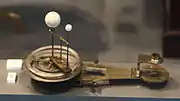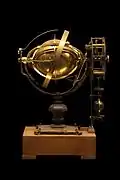A tellurion (also spelled tellurian, tellurium, and yet another name is loxocosm), is a clock, typically of French or Swiss origin, surmounted by a mechanism that depicts how day, night, and the seasons are caused by the rotation and orientation of Earth on its axis and its orbit around the Sun. The clock normally also displays the age of the Moon and the four-year (perpetual) calendar.[1]
It is related to the orrery, which illustrates the relative positions and motions of the planets and moons in the Solar System in a heliocentric model.
The word tellurion derives from the Latin tellus, meaning "earth".[2]
 A tellurion made in 1766, used by John Winthrop to teach astronomy at Harvard
A tellurion made in 1766, used by John Winthrop to teach astronomy at Harvard Tellurion made between 1700 and 1725, on display at the Musée des Arts et Métiers, Paris
Tellurion made between 1700 and 1725, on display at the Musée des Arts et Métiers, Paris
See also
References
- ↑ De Carle, D. (1988). Watch and Clock Encyclopedia. London: NAG/Robert Hale.
- ↑ Shipley, Joseph Twadell (2001). The Origins of English Words: A Discursive Dictionary of Indo-European Roots. JHU Press. p. 403. ISBN 0801867843.
External links
Wikimedia Commons has media related to Tellurium (device).
Look up tellurion in Wiktionary, the free dictionary.
This article is issued from Wikipedia. The text is licensed under Creative Commons - Attribution - Sharealike. Additional terms may apply for the media files.
